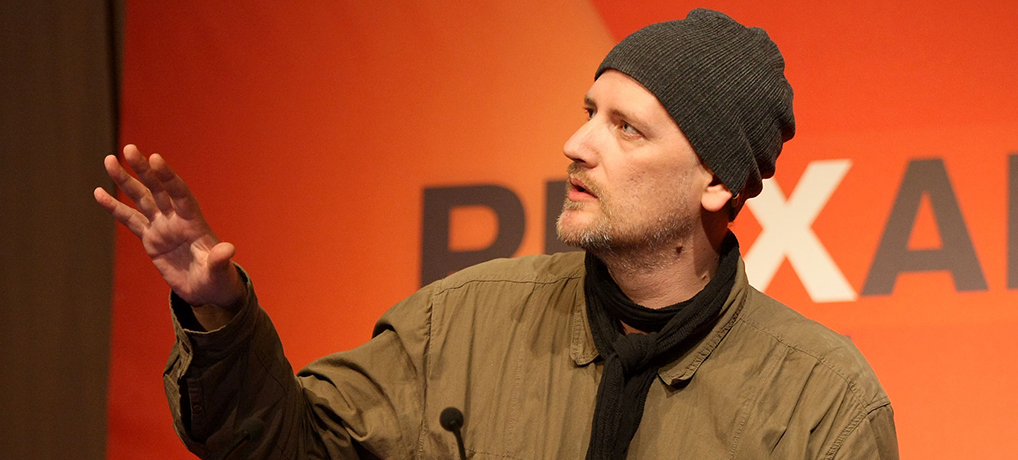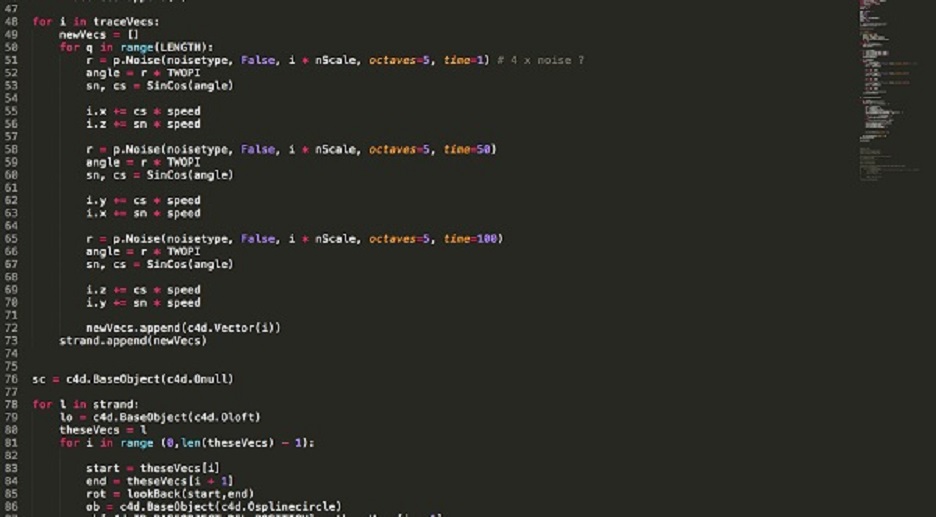Glenn Marshall: Creating Art from the Python Language
Guest blog by Glenn Marshall
About a year ago I finally found the perfect medium to work in.
Using the Python language, I discovered it was possible to basically hijack the entire system of Cinema 4D and use it like a graphics and rendering library.
I began my artistic profession a long time ago as a 3D animator – but I always wanted to experiment and push boundaries of what was visually possible – but at that time you could only use the built in tools and interface to create stuff which just made me frustrated. Then I discovered Processing – the programming language to create visual computer art. That was a revolution for me, and I spent the last several years creating animations this way – what would be called code art.
But the only thing I found limiting was the rendering and graphics output – you couldn’t really do anything sophisticated with lighting, cameras, FX, materials, complex geometry creation etc. But now with the Python SDK and Cinema 4D I can code all the conceptual ideas I had with Processing, but have the beauty and power of one of the most powerful movie standard 3D animation and special FX applications in the world.
This now allows me to write full code to create and animate anything and everything, and Python is a beautiful, beautiful language.
Below is literally the first thing I created. It’s based on my obsessive love of vector fields (used to animated things like flowing water, and flock animation). The challenge was to create geometric structures in a 3D vector field. All my previous work in this was with Processing and in 2D. Anyway, after about a week learning Python and the SDK I finally knocked out some impressive first results.
Below is a rendered still, a snapshot of the code that created it, and a snapshot of how it looks sitting inside Cinema 4D.
This is how I would create all my future work.
My most recent work is Particle Man.
This is an experimental digital work created using programming code to simulate mathematical and scientific models of particle collisions to create 3D sculptural forms.
Thousands of particles are released from a source in 3D space in close proximity to an invisible geometric shape of a human head. Using newtonian physics to calculate the force, acceleration and mass of each particle – the software code simulates the trajectory and collisions of each particle. The human head then starts to fill up with particles that collect inside and reveal the head shape with the various densities of particles. Many particles also ‘miss’ and fall out into space around the head.
This is what I would call ‘emergent art’, in that I have no preconceptions of the final result, but rather rely on the unexpected results of a complicated simulation system using natural forces to create the final piece.
In this work, I wanted to express something ultimate and universal about humanity, science, the mind and the cosmos, expressed in a literal sense by particles, and metaphorically through the figurative.
Particle Man is the first in a series of 4 created with the same techniques, and is also an animation. The animation is currently nominated for The Lumen Prize (to learn more about the Lumen Prize visit http://lumenprize.com).
Particle Man will also be showing at roBOt08, Italy. I love it when people can describe my work better than I can:
A constantly evolving play of references between human and cybernetic, with the most intricate and genius 2.0 creative craftsmanship: “Particle Man.” Immersive spaces, 3D digital sculptures created in the image and likeness of mathematical and scientific models. A manic 2.0 craftsmanship, made of studies in Newtonian physics to investigate forces, accelerations and the mass of individual particles of matter – narrated and created via software. They are intended to create a human head, including deviations, escapes, sudden drifts, where the final result is never certain. “Emergent art” as the Irishman Glenn Marshall calls it. He boasts a high level prize list for its activities in computer animation and motion graphics, as well as the outstanding achievement of having been able to work closely with Peter Gabriel. His works, available on his Vimeo profile, exceeded the million views mark (http://www.robotfestival.it/2015/events/call4robot/48/glenn-marshall.html).
Self Portrait
In this variation, I tried to represent myself, liberated by the creative power of technology, but also perhaps trapped by its lure, and disconnecting from reality.
Star Girl
In this piece, the inspiration came from how the female form has been a key subject in the history and evolution of art, from the renaissance to the modern era, and here presented as an example in the digital era.
Universe Hand
In Universe Hand, I switch between 2 noise types, which control the flow fields for the particle stands. I alternate between ‘cloud’ like noise for organic, natural flow, and ‘block cell’ noise to create a linear circuit-like flow. The particles also expand and contract in sync with the Indian yogic breathing technique ‘Pranayama’ – in this video ‘inhaling’ for 8 seconds, and ‘exhaling’ for 4 seconds.
There are parallels to the scientific model of an infinitely expanding and contracting cycle of the universe, and also referring to the Hindu mystical idea of Vishnu, the creator and destroyer of each universe cycle with his in-breath and out-breath.
I then took all my animations and pieced them together to fit a Radiohead song as a personal project.
Born in Belfast in 1973, computer artist and animator Glenn Marshall is a Prix Ars Electronica winner, and currently nominated for The Lumen Prize, considered the two most prestigious digital arts awards in the world. His works are entirely created through programming and code art, forged in the belief that with commercial software a computer artist is always limited by the features and interface of a software application, but with self made code art, the limits are boundless, only constrained by your own theories and imagination.
In 2008 he won the prestigious Prix Ars Electronica for a music video he created for Peter Gabriel – unique in that it was created entirely out of programming and algorithms. Another of his videos features on Gabriel’s ‘Best Of’ DVD compilation. Glenn has also collaborated with Peter on his concert stadium visuals.
Inspired by science and nature, the meditative and the abstract, and with a philosophical narrative, his work spans 20 years, winning awards and screened at many festivals world wide. His animations alone have over 1 million views on Vimeo. Many of his self coded works, from animated films to interactive mobile apps, have been exhibited throughout Europe and New York. He is currently a recipient of the Major Individual Award from the Arts Council of Northern Ireland, their highest recognition given to leading artists in the country.
Click the links below to learn more about Glenn Marshall and his work:
Website: www.butterfly.ie
Twitter: @glenniszen
If you’re interested in writing a guest blog, send us your portfolio to social@wispeo.com!
Wispeo is now mobile! Get the easiest way to share videos and photos from your phone in the App Store or from Google Play.









hello Glen, i am a fan of your art and a legally blind .gif artist. recently i made a .gif of your work, stargirl and wanted to share with you. here is a link, hope you enjoy it
https://plus.google.com/b/103319792516271097294/+DarkAngel0ne/posts/CK9jv4pWtNj
all my best,
George RedHawk